
© Peter Snadik. (Click image for larger version)
Aerowaves – Spring Forward
Performances by:
Spitfire Company: One Step Before the Fall
BOD.Y: BAKKHEIA – dancing on the edge
Euripides Laskaridis / Osmosis Theatre Company: Relic
Vilma Pitrinaite / We Company: Miss Lithuania
Meytal Blanaru: AURORA
Giorgia Nardin: All dressed up with nowhere to go
Ayelen Parolin: Hérétiques (Heretics)
Marco da Silva Ferreira: Hu(r)mano
Location X / Taneli Törmä: ZOOM
Ugne Dievaityte and Poliana Lima: Flesh
Barcelona: Mercat de Les Flors, Antic Teatre, Institut del Teatre, Graner Fàbrica de Creació
18, 19 April 2015
www.aerowaves.org
www.aerowaves-springforward.org
Spring Forward is a three-day festival of contemporary dance, presented by Aerowaves, which confidently declares itself to be a ‘hub for dance discovery in Europe’. The annual Spring showcase began (in 2011) with an event in Slovenia, and this fifth iteration descended upon the Catalan capital of Barcelona; the hilly home of Lionel Messi, La Rambla, colourful dancing fountains and a considerable reputation for avant garde performance art.
Around 200 programmers, producers, theatre managers, arts journalists and artists took part, drawn from around 40 countries, including many from outside Europe (Canada, Chile, China, South Korea, Taiwan and the USA). Led by John Ashford CBE – former long-time Director of The Place – and very efficiently managed by a small team under the unflappable General Manager, Anna Arthur, it has grown into a significant enterprise for drawing dance across Europe into one place and time.
With 23 productions from 18 countries, providing up to 12 shows a day, presented in five venues around central Barcelona, it felt like a condensed version of the Edinburgh Fringe, mixed with a distinct flavour of Eurovision, although the only competitive process is being selected to perform. The brand has also diversified, spawning a programme known as the Springback Academy, which (like Resolution Review! in the UK) provides a mentored opportunity for aspiring dance writers to develop the art of criticism. The four mentors included Donald Hutera and Sanjoy Roy from the UK. I met several of the aspiring young writers at a seminar on dance criticism during the final day of the festival and the future of dance writing seems to be in enthusiastic and suitably opinionated “hands”.

© Elsa Okazaki. (Click image for larger version)
I chose to see ten productions taken from the Saturday and Sunday sessions to provide a random selection of almost half the festival entries. The shows that I missed included the two UK presentations – Dan Canham’s 30 Cecil Street and Igor and Moreno’s Idiot-Syncrasy. Of the other eleven productions omitted from my sampling, I heard good things about the operatic melodrama of Hodworks’ Conditions of Being a Mortal (from Hungary) and the Austrian presentation of Deutinger & Gottfarb’s dance in knightly armour, Chivalry is Dead. I regretted missing these two but one can’t be everywhere at once!
A general criticism of the works that I saw is that most ignored the vital rule of “less is more”. Six of my ten pieces were scheduled to last for 40 minutes; two others for 35; and one for 30 (the remaining work being just 15 minutes’ long). Almost all seemed longer that their allotted time (indeed one double bill over-ran by an hour against the schedule) and they generally failed to grasp obvious opportunities for a more satisfying conclusion, often being extended with additional sections beyond a point that would have provided a more rounded product. .
My Saturday marathon of five hours’ dance and eleven kilometres of walking between venues (not counting a bus ride and a metro journey) began at the Graner Fàbrica de Creació, a theatre renovated from a former granary, for an Eastern European double bill. First up was Spitfire Company’s One step before the fall; a powerful, pugnacious, pugilistic case against the debilitating effects of boxing by this already well-established dance theatre company from the Czech Republic, directed by Petr Boháč.
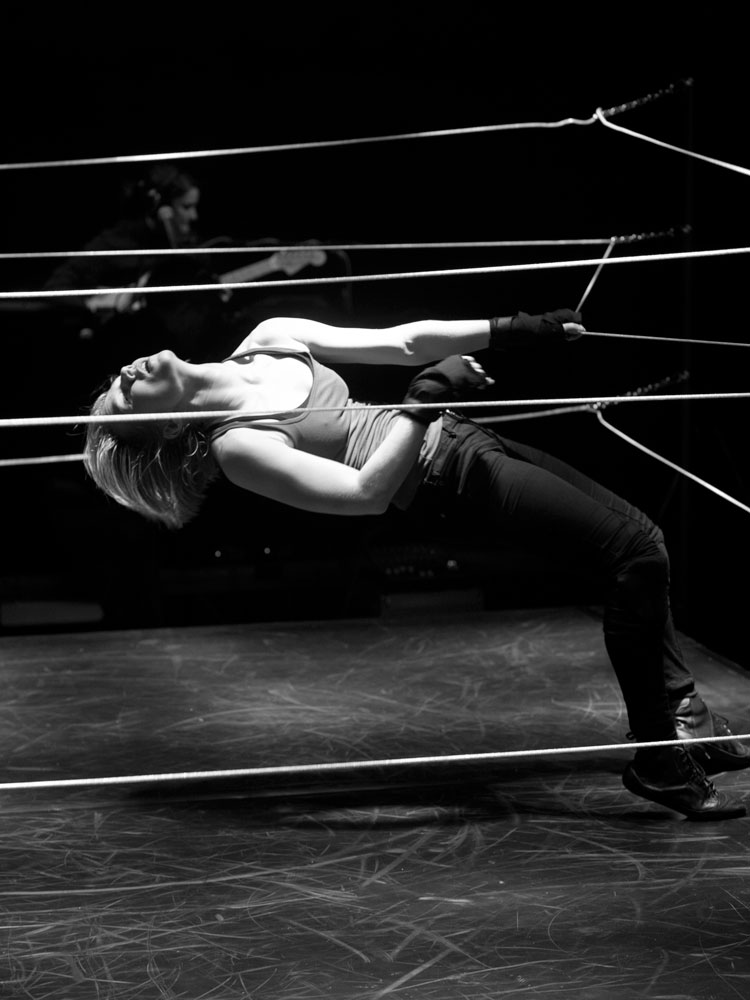
© Martin Marak. (Click image for larger version)
The work begins with the barely audible recorded voice of Muhammad Ali – struggling with the long-term effects of Parkinson’s Disease – justifying his over-long career in the ring with the view that it was all worthwhile for the fame and the fact that people still want to interview him, even in these dark days of such severe illness. The piece enjoys strong production values – it includes the construction of an actual boxing ring as part of the choreography – and a lively sense of theatre. A solo mimed dance performance of great intensity by the choreographer, Markéta Vacovská, is also effectively a duet, given the significance of the live music and vocals from Lenka Dusilová. The dynamic and deadly mix of punishment and exhaustion endured by the boxer was conveyed with startling imagery, perhaps even more powerfully in being portrayed by a woman. It was a very strong benchmark with which to start my Aerowaves experience.
Next up at the Graner was BOD.Y, a company from Slovakia, with a work entitled BAKKHEIA – dancing on the edge. It seemed more like 3 or 4 unconnected works, loosely stitched together. Starting with a long sequence in which three performers shimmered away, silhouetted in darkness at the rear of the stage, it was impossible to judge gender or whether they were clothed or naked; as the lights came up it turned out to be two women and a guy, wearing an assortment of summer clothes. They continued the shimmering, performing the oddest of semi strip-teases as shorts and jeans gradually slipped to the floor and shirts were removed. An interlude in this process involved manipulating an overhead projector displaying meaningless English text, leading into a finale of the performers (now in “pick ‘n mix” underwear) coming into the audience, while Purcell’s religious music played in the background. I confess to receiving a very long and sweaty – but nonetheless enjoyable – cuddle from the group’s leader, Soňa Ferienčiková, which created a peaceful vibe that lasted well into lunch.

© Peter Snadik. (Click image for larger version)
This was the least cohesive or linear of all the works and not everyone will enjoy the intrusiveness of BOD.Y’s very intimate audience interaction. The movement quality of the three dancers was always absorbing but it came in spurts between other sections (including the overhead projector scene) that added nothing. It could have been condensed into a piece half as long that may have had much greater impact.
A bus ride across Barcelona took us to the Antic Teatre; a concealed oasis of performance art, sited off a beautiful courtyard, reached through a small opening in a street near to the cathedral. It is a hidden place that thousands of people walk by, each day, unaware of its existence. A small presentation about the theatre, emphasising its purpose as a place for challenging, risk-taking performance, led into just such an episode of anarchic, physical theatre that will live long in the memory. Euripedes Laskaridis is a Greek exponent of the theatre of the absurd, without inhibition and possessing enormous charisma.

© Alexandros Mistriotis. (Click image for larger version)
Relic is about a woman; we may deduce that she was once a performer. She inhabits a makeshift room, decorated haphazardly, in which we are introduced to her fleetingly in short, flickering bursts of illumination. Laskaridis is dressed in an extraordinary costume, giving the impression of enormous buttocks and thighs, with a C- shaped spine curving up into tiny breasts. “Her” hair is piled up into giant rolls all held together with a stretch nylon face mask that reveals only the performer’s dark eyes. Thighs and buttocks are divided up into sections with writing on the “skin”.
This grotesque, tall figure at once reminded me of an “exhibit” that Victorians would have paid to see in a fairground “freak” show; a carcass showing cuts of meat in a butcher’s shop; or tattoos on the bodies of concentration camp victims. Laskaridis put on a long white shroud-type gown before singing and speaking in a ridiculous and inaudible falsetto; he tottered around in stilettoes, played with a giant ball, mimed urination on the head of a white “Roman head” statue as if it were a toilet and carried out some bizarre, makeshift DIY.
In his final sequence Laskaridis discarded the woman’s persona, assuming the facial image of an absurd “Hitler” – albeit with curly hair – carrying out some ridiculous “cabaret-style” activities. The work would have been better had he not strayed from the original vaudeville relic, in her strange dressing room, as this later section added nothing for me. Nonetheless, Laskaridis took his audience on an extraordinary journey of absurd slapstick and ridicule.
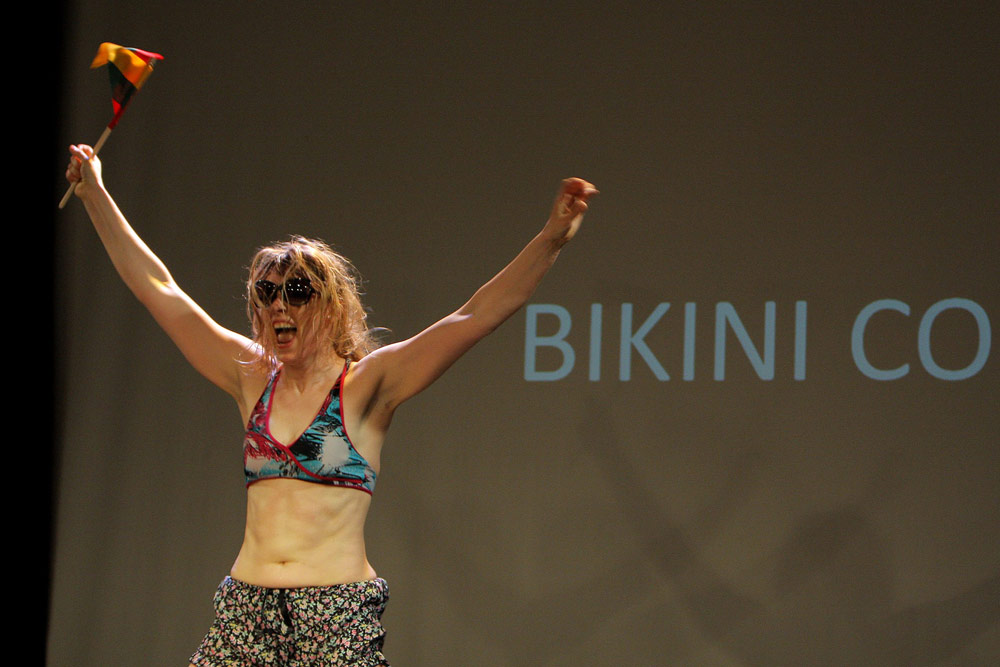
© Dimitrijus Matvejevas. (Click image for larger version)
He was followed by Vilma Pitrinaite’s tongue-in-cheek satire on both beauty pageants and her homeland in Miss Lithuania. Again, this was very much a game of two halves: it started with a great deal of comedic value, showcasing Pitrinaite’s qualities as a charismatic (and sexy) performer. Her overblown jingoistic pride in Lithuania, both live on stage and in an accompanying film about her country, displayed great comic timing. But, this soft, sentimental, ironic approach to the best things about Lithuania (bee-keeping, national dances, folk songs about little lambs and mosquitos) took a dark side when Miss Lithuania spoke about her country atrophying because no-one wants to go there and all the young people want to leave. Beyoncé then somehow took over from the Lithuanian folk songs and the whole event descended into a sleazy gig in a seedy nightclub with Miss Lithuania’s sweetness and light morphing into an insanity that brought the whole affair to an abrupt and rather inconclusive end. It seemed to be a work that began with one purpose and ended in an altogether different place; like starting with Frozen and ending with Saw!
The efficient organisation of the event, shepherding delegates from one venue to another went somewhat awry with this programme at the Antic Teatre finishing an hour late, just as the next show was about to start in another part of Barcelona. Everyone was left to their own devices, but thanks to my secret weapon (a companion who has lived in the city) we were able to find our way to the Sala Pina Bausch at the central venue of Mercat de les Flors, arriving 45 minutes after the next show was due to have begun. But, the wonder of Aerowaves is that they held the start for us all to arrive piecemeal and the Israeli dancer, Meytal Blanaru – now based in Belgium – was kept waiting for almost an hour before performing her mercifully short, 15-minute solo, Aurora.
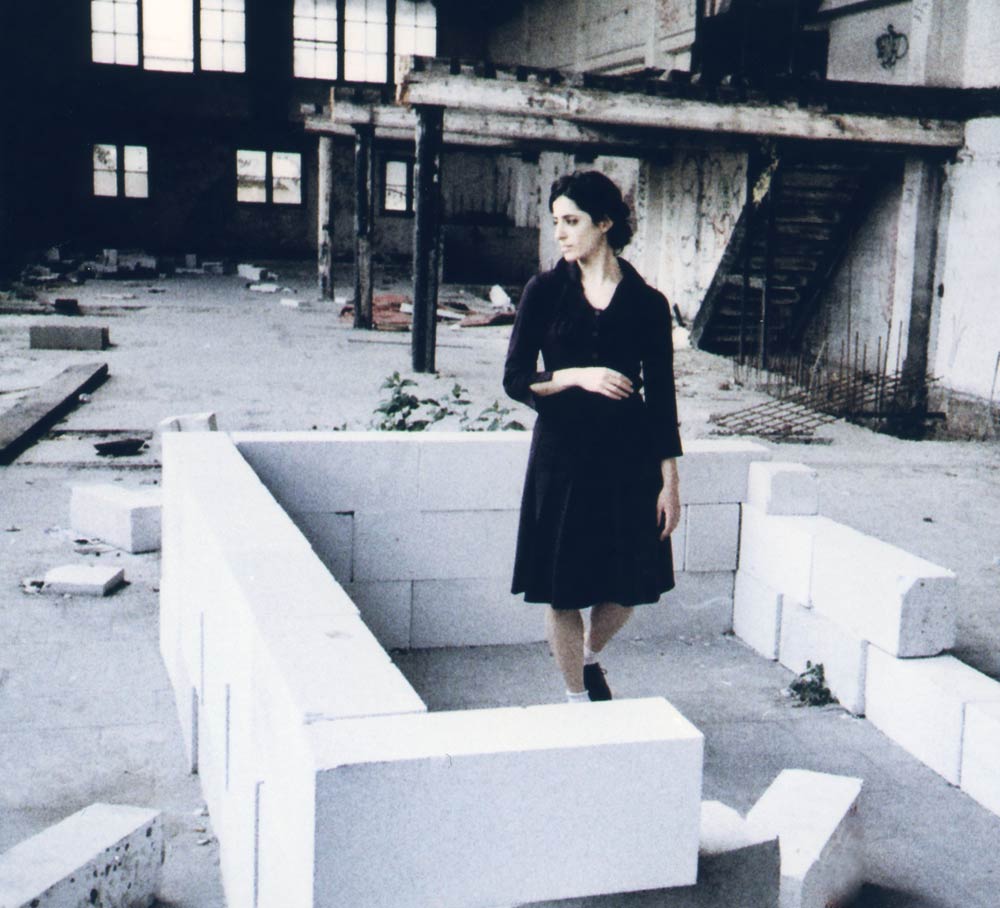
© Julie Calbert. (Click image for larger version)
Despite some opening nonsense with shoes – discarding and, apparently, sniffing them – this turned out to be one of the best illustrations of pure dance amongst my ten samples. Blanaru’s theme was to capture the essence of feral children and she did so with an extraordinary movement quality, utilising the kind of isolated, muscular control of hip hop poppers and lockers alongside the whole-body fluidity of contemporary dance. She left me wanting more, which was the exception in this packed weekend of dance.
Giorgia Nardin’s All dressed up with nowhere to go was the sole Italian entry to the festival. Two dancers – Marco D’Agostin and Sara Leghissa – stood, up close and personal to the front row of the audience, wearing only expensively-tailored and perfectly-pressed shirts, tentatively balancing on one leg with one foot resting on the other. This opening sequence lasted for too long but as their bodies wobbled around and the shirts began to wrinkle and ride up, one became aware of the genitalia peeking out from below the hems. Eventually, the shirts were discarded revealing both total nudity and the best moments of the work in an engaging sequence of tenderness with Leghissa holding, carrying and comforting her partner; leading into the sentimental melancholy of D’Agostin singing softly while Leghissa listened intently, gazing abstractly into the distance. They were no longer dressed but they clearly had somewhere to go since it evoked a late night sing-song around the campfire on a “scouting for nudists” holiday.

© Alice Brazzit. (Click image for larger version)
The dance with the most scientific intelligence – and certainly the most difficult to perform – was Ayelen Parolin’s production of Heretics for the Belgian company, Cie, which opened the Saturday evening session in the Sala Ovidi Montllor at the Institut del Teatre, adjacent to the Mercat de les Flors. This long ritualistic piece required intense concentration by the two performers – Marc Iglesias and Gilles Fumba – who stood at the front of stage, while performing intricate sequences of arm movements based on triangles. There were thousands of these geometric patterns, performed both in silence and to the sounds of a live piano, both in terms of notes and the percussive sounds of banging on the frame. The absolute unity of the two guys’ movement required an intense marathon of concentration. It was a relentless and remarkable exposition of harmony, taking me back to Barcelona in 1992, since it was a feat worthy of an Olympic Gold Medal in synchronised movement.

© Charlotte Sampermans. (Click image for larger version)
My Saturday at Aerowaves concluded with Marco da Silva Ferreira’s Hu(r)mano, choreographed on a quartet of performers (Anaísa Lopes, Gonçalo Cabral, Marco da Silva and Vitor Fontes). This Portuguese entry was another that shifted shape over its 40 minutes, beginning with a windblown sea soundscape, in which the four dancers resembled strange avian creatures (perhaps crossing a penguin and a rooster). There was clever interplay between the dancers, layering their bodies and resting parts of themselves into the gaps made by their colleagues’ shapes. Their dance style appeared to fuse street movement with contemporary techniques, all cleverly bathed in soft lighting by Wilma Moutinho, but – as with so many of the other pieces (and especially at the end of a long day) – it failed to engage my attention to the end.

© João Vidal. (Click image for larger version)
Sunday started with the aforementioned seminar on criticism followed by an experience so bizarre it is worth putting into the “priceless” box. The UK-based choreographer and performer (twice nominated for a National Dance Award), Sally Marie, was in Barcelona to carry out live stream interviews on an app called Meercat (she was, indeed, the Meercat at the Mercat) and she asked me to give an interview between the seminar and the subsequent performances. We were merrily chatting away on camera when she asked me for an opinion on a piece that I hadn’t seen. When I revealed this omission she said “oh, we better start again”, casually adding the throwaway line, “..no-one is watching anyway”! After the interview, I discovered that these live streams are like Snapchat – they’re live and that’s it! There’s no chance to go back and see them later. Sally told me that – in fact – no-one had watched our interview live; and obviously, therefore, no-one would ever be able to see it! My viewing audience of zero only added to that Eurovision feeling; with me being the Finnish entrant with nul points!
Speaking of which brings me to ZOOM by a guy called Taneli Törmä, a Finnish choreographer now based in Denmark, making productions under the brand of Location X. Törmä is a big guy and – if I may say so – rather undancerly in his physique. When he walked calmly out of the shadows before the piece began, wearing a large fuzzy beard and casual grey shirt and jeans, I thought he was a technician come to check something! In fact, when he gets going, Törmä has a rather beautiful movement quality: slithering, undulating and surprisingly light for such a big physique. He stared – sweetly and inquiringly – at the audience for long periods, building a rapport, and played with Petri Tuhkanen’s lighting design in a very unusual way, as if it were his partner. He danced inside and around the light. It was a gentle, quirky and very unusual piece.

© Uupi Tirronen. (Click image for larger version)
A female duet – also in the Sala Pina Bausch – brings my selective tour of Aerowaves 2015 to an end. Performed by two dancers now based in Spain but originally from Brazil (Poliana Lima) and Lithuania (Ugne Dievaityte), it was another work that started beautifully but failed to build upon this arresting opening platform. Entitled Flesh, the two women sat on the floor at the rear of the performance area, their naked backs bathed in soft light, creating gorgeous and unusual patterns and shapes in the geometry of their silent interaction. It was a surreal and sensual experience.
Later they dressed in loose black garments while each dancer performed an exhausting physical solo and – discarding their tops – they then began to push each other around with physical abuse. The beauty of the earlier sequence gave way to a volatile and uncomfortable topless female wrestling match. Very attractive breasts were certainly a compensating factor but even that seductive interest wore off, after a while. Here was yet another example of a work that began with such promise but diversified unnecessarily – with no obvious purpose – to last several minutes’ beyond a more obvious point of conclusion.
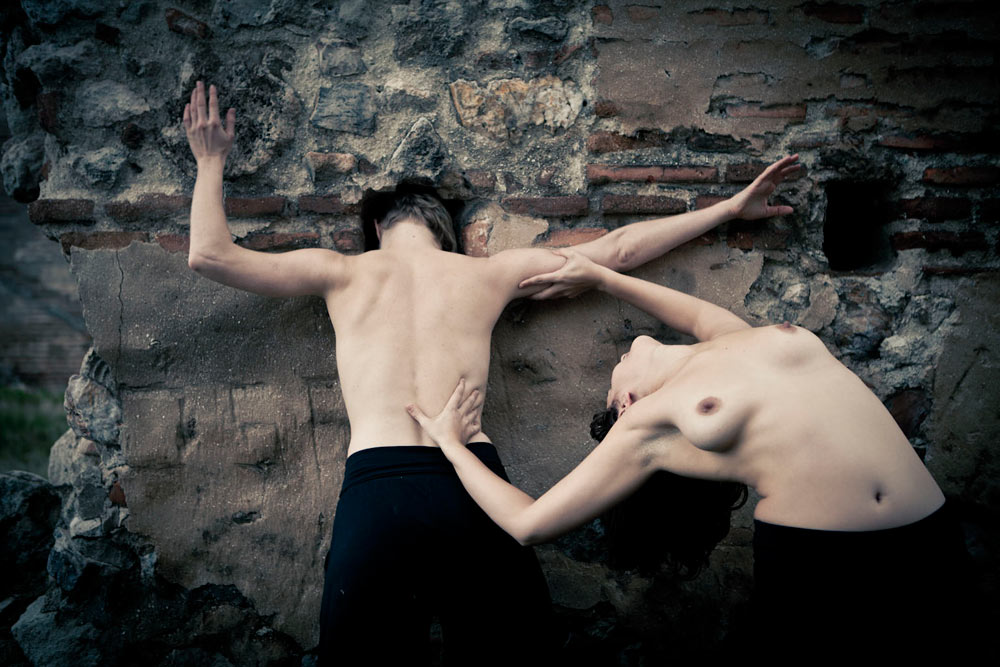
© Barbara Crosetti. (Click image for larger version)
My arbitrary ten productions were about as broad a selection of modern dance theatre as it gets: from anarchic, absurd physical theatre to pure dance; from mathematical formulas to moving sculpture; elaborate spoken text to silence; complex sets to nothing but a dance floor; bespoke live music to recorded Bach; expensive costumes to nakedness; from directly engaging the audience to ignoring the presence of a fourth wall. There was nothing that I wished I hadn’t seen although many works over-killed their achievement by trying for that extra section.
Most importantly, Aerowaves’ Spring Forward Festival has introduced me to the work of many choreographers and performers that I would very much like to see again. It may have taken me five iterations of the festival to participate in it but I plan to bounce back to Spring Forward in 2016 and thereafter.








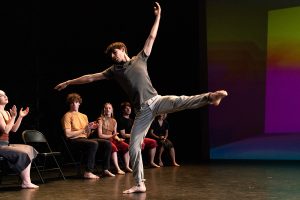





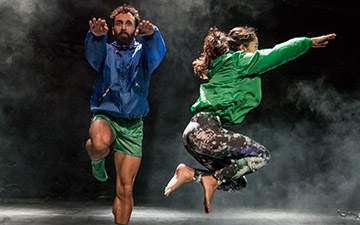

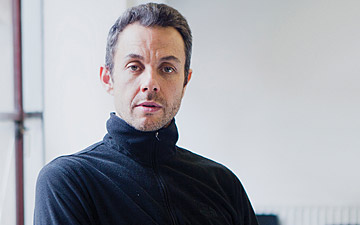
You must be logged in to post a comment.